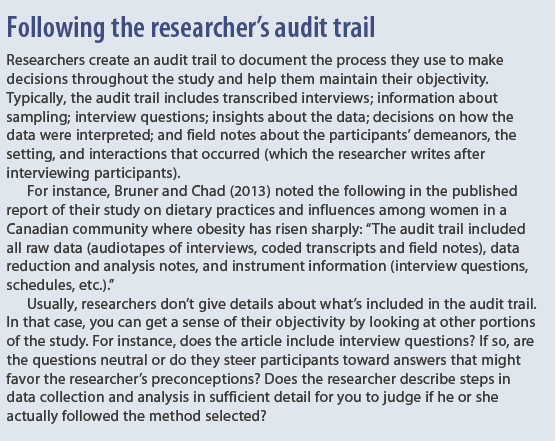Editor’s note: This article is a follow-up to “Understanding qualitative research,” published in the July issue of American Nurse Today.
Have you ever told someone a story and then later heard the listener retell it in a way that made you say, “That’s not what I meant!” This happens because as listeners, we filter what we hear through our own experience, knowledge, or preconceptions, which can make us misinterpret the intended meaning.
Similarly, researchers who conduct qualitative studies listen to people’s stories about their experiences. These stories form the foundation for the themes that will serve as the basis of the study results. Obviously, researchers need to capture study participants’ intended meaning so their results don’t merely reflect their own experiences. In other words, the findings must be trustworthy.
How can you evaluate the trustworthiness of a qualitative study? As you read it, ask yourself, “How did the researcher address the issue of potential bias?” Researchers can incorporate strategies into the study design to reduce bias; the published report of the study should describe these strategies.
This article discusses strategies researchers use to make their study findings more trustworthy. They’re based on criteria developed by Lincoln and Guba in 1985 (considered the gold standard for evaluating the quality and trustworthiness of qualitative research). The strategies fall into the broad categories of confirmability, credibility, dependability, and transferability.
Confirmability
Confirmability refers to the objectivity of study findings. To achieve objectivity, researchers commonly use reflexivity and an audit trail. (See Following the researcher’s audit trail.)
Reflexivity
Through reflexivity, researchers examine their own thoughts, feelings, and opinions on the study topic and remain constantly aware of their preconceptions throughout data collection and analysis. Keeping a reflexive journal can help them identify their preconceptions and see study participants’ meanings more clearly.
For example, Pearson (2013) studied cancer nurses’ experiences of providing palliative care to children in an acute-care setting. Acknowledging that she came to the study with preconceived notions, she used a reflexive journal to decrease bias potential. In her article, she stated, “The researcher used a reflexive diary [that] provided a consistent and systematic documented account of the participants’ interviews…
The use of reflexivity was important to consider as the researcher came to the phenomenon with a set of preconceptions and experiences that could have influenced the way the experience was described by the participant and the way the data was collected, interpreted, and analyzed.”
Credibility
Credibility refers to how well the study findings represent the data. The most common ways to establish credibility are peer debriefing and member checking.
Peer debriefing
Peer debriefing occurs when two or more researchers analyze the study data and compare results until they reach a common understanding. This step is important because a researcher may be aware of having preconceived ideas on the topic but unaware of when and how these notions might be influencing data interpretation. This is more likely when the researcher is closely involved with the study topic.
For example, Cameron and Waterworth (2014) conducted a study of patients’ experiences with palliative chemotherapy for colorectal cancer. In the data analysis section of the published report, they explained how they addressed the possible bias of one of the researchers, a nurse who worked on the unit where patients were treated: “Transcripts were read by SW following initial analysis by JC, and codes and themes were discussed to consider different interpretations and enhance rigor and trustworthiness. This also enabled JC as a nurse with clinical experience working in the day unit to reflect on her experience and how it could influence the interpretation of the data.”
Member checking
In member checking, the researcher presents findings to the study participants and asks them if the interpretations he or she made are consistent with their experiences. The researcher incorporates participants’ feedback into the findings. Thus, member checking ensures that the data are true to the participants’ experience.
Bowen, MacLehose, and Beaumont (2011) studied family relationship and support needs of patients with advanced multiple sclerosis, interviewing 25 family members in a multisite study. Here’s how they describe their member-checking process: “For the interviewees, this involved two-member checking meetings when participants were asked to read a lay summary of the findings and to comment on the accuracy of the summary, and to give any further reflections. For those who could not attend, a copy of the findings was sent…with contact details should they wish to comment.”
Dependability
Dependability refers to consisten-cy of the findings; it’s achieved through an external audit of the study. In the audit, another researcher who is not connected to the study but has qualitative research experience examines the audit trail, including study findings and conclusions. The auditor looks for a logical progression from the raw data (participants’ descriptions) to the interpretations, findings, and conclusions of the study.
When an external audit is done, details of the auditor’s response usually aren’t given in the published study. But as the reader, you can look at portions of the study to evaluate whether a logical progression exists between raw data and interpretations. In the findings section, the researcher presents the themes, with verbatim quotes from one or more participants that support the themes. You might ask yourself, “Can I easily grasp the connection between the theme and the quotes that support it?” If not, the interpretations may not reflect the participants’ intended meaning.
Here’s an example of a theme with a supporting quote from a study on the experiences of obstetric nurses who were present during a perinatal loss.
• Study theme: responses to the loss; shaken to the core
• Participant quote (from a nurse who discovered the loss): “I could not locate the baby’s heart rate. I started to feel numb. I felt hot and cold at the same time. I literally heard my own heartbeat slowing down. It was loud and pounding ever so slowly; I could hear it. We got a STAT ultrasound, which showed no cardiac activity…I could not work for the rest of the day.”
In this example, you can see a clear connection between the theme and the verbatim quote (the supporting data).
Another way to judge dependability is to evaluate the study’s conclusion section to determine if conclusions flow from the findings or if the researcher has made a leap, drawing conclusions beyond what the findings suggest.
Transferability
When reading a research study, you may want to know if the findings can be applied to the patients you care for; in other words, can they be transferred to another setting and another population? The researcher is responsible for providing “thick descriptions”—rich, vivid descriptions of participants, their experiences, and the setting. The quote from the obstetrics nurse above exemplifies a thick description of her experience. Artwork, photographs, and documents can augment patients’ verbal descriptions and enhance data richness. A study that contains thick descriptions can contribute to the body of evidence that helps you make judgments about implementing practice changes in your setting.
Evaluating qualitative research presents unique challenges not encountered with quantitative research. However, thoughtful examination of qualitative studies can help ensure such research is useful to nursing practice.
Barbara Williams is a nurse scientist at Meridian Health in the Ann May Center for Nursing and Allied Health in Neptune, New Jersey, and an instructor in the nursing program at William Patterson University in Wayne, New Jersey. She is coauthor of Anatomy of Research for Nurses.
Selected references
Bowen C, MacLehose A, Beaumont JG. Advanced multiple sclerosis and the psychosocial impact on families. Psychol Health. 2011;26(1):113-27.
Bruner BG, Chad KE. Dietary practices and influences on diet intake among women in a Woodland Cree community. J Hum Nutr Diet. 2014;27 Suppl 2:220-9.
Cameron J, Waterworth S. Patients’ experiences of ongoing palliative chemotherapy for metastatic colorectal cancer: a qualitative study. Int J Palliat Nurs. 2014;20(5):218-24.
Lincoln YS, Guba EG. Naturalistic Inquiry. Newbury Park, CA: Sage Publications; 1985.
Pearson HN. “You’ve only got one chance to get it right”: children’s cancer nurses’ experiences of providing palliative care in the acute care setting. Issues Compr Pediatr Nurs. 2013;36(3):188-211.
Puia DM, Lewis L, Beck CT. Experiences of obstetric nurses who are present for a perinatal loss. J Obstet Gynocol Neonatal Nurs. 2013;42(3):321-31.



















